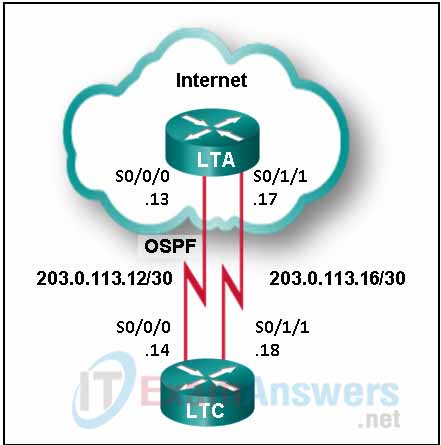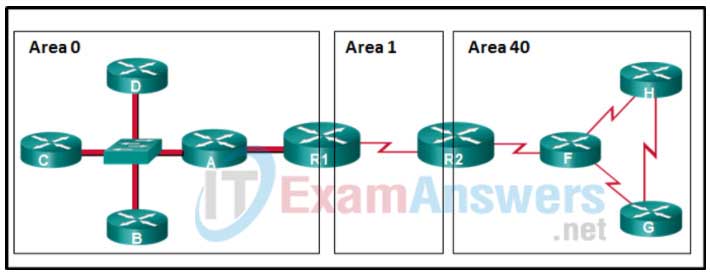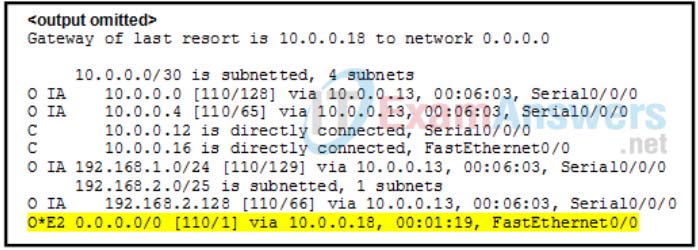1. Which command should be used to check the OSPF process ID, the router ID, networks the router is advertising, the neighbors the router is receiving updates from, and the default administrative distance?
- show ip protocols
- show ip ospf neighbor
- show ip ospf
- show ip ospf interface
2. A network engineer is tracing packets through the network but packets are not load balancing over paths as expected. What are two actions the engineer should take? (Choose two.)
- Check priority values on interfaces.
- Check summarization on ABRs.
- Use the
show ip protocolscommand to verify the maximum number of paths that are allowed to load balance. - Check end-to-end costs.
- Verify if any distribute lists are applied.
3. Refer to the exhibit. LTC has an OSPF neighbor relationship with the router LTA over the 203.0.113.12/30 network. The 203.0.113.16/30 network link should serve as a backup when the OSPF link goes down. The floating static route command ip route 0.0.0.0 0.0.0.0 S0/1/1 100 was issued on LTC and now traffic is using the backup link even when the OSPF link is up and functioning. Which change should be made to the static route command so that traffic will only use the OSPF link when it is up

- Add the next hop neighbor address of 203.0.113.16.
- Change the administrative distance to 1.
- Change the destination network to 203.0.113.13.
- Change the administrative distance to 120.
4. A network administrator has just changed the router ID on a router that is working in an OSPFv2 environment. What should the administrator do to reset the adjacencies and use the new router ID?
- Configure the network statements.
- Change the interface priority.
- Issue the clear ip ospf process privileged mode command.
- Change the OSPFv2 process ID.
5. A network engineer has noted that some expected network route entries are not displayed in the routing table. Which two commands will provide additional information about the state of router adjacencies, timer intervals, and the area ID? (Choose two.)
- show ip protocols
- show ip ospf interface
- show ip route ospf
- show ip ospf neighbor
- show running-configuration
6. In an OSPF hub-and-spoke topology, what needs to be done, if anything, to ensure that the spoke routers would never be selected as DR and BDR?
- Because nonbroadcast networks do not elect a DR/BDR, nothing needs to be done.
- All routers must be configured with an OSPF interface priority of 0 (ip ospf priority) to disable the DR/BDR election process.
- All spoke routers need to be configured with an OSPF interface priority of 0 (ip ospf priority) so that they will not become the DR/BDR.
- One of the spoke routers will need to be configured as the DR by setting the OSPF interface priority higher than 1 (ip ospf priority).
7. Refer to the exhibit. In this scenario, Area 40 cannot be connected directly to Area 0. Which OSPF network type must be configured in Area 1 to connect these areas?

- point-to-point
- virtual link
- point-to-multipoint
- nonbroadcast multiaccess
8. Refer to the exhibit. A network administrator issued the command show ip ospf interface on the router R2. What conclusion can be drawn?

- R2 is connecting to a point-to-point network.
- R2 has not formed an adjacency with any other router.
- R2 is configured with the OSPF router-id command.
- R2 is not configured with default Hello and Dead timer values.
9. Refer to the exhibit. A network administrator has configured OSPFv2 on the two Cisco routers as shown. PC1 is unable to connect to PC2. What should the administrator do first when troubleshooting the OSPFv2 implementation?

- Test Layer 3 connectivity between the directly connected routers.
- Turn off OSPFv2.
- Disconnect the serial link between router R1 and R2.
- Implement the network 192.168.255.0 0.0.0.3 area 0 command on router R1.
10. Refer to the exhibit. How did this router learn of the highlighted route in the routing table?

- by entering the router configuration mode command default-information originate
- by entering the global configuration mode command ip route 0.0.0.0 0.0.0.0 interface-type interface-number
- by entering the global configuration mode command ip route 0.0.0.0 0.0.0.0 ip-address
- by receiving an update from another OSPF router that is running another routing protocol
- by receiving an update from another OSPF router that has the default-information originate command configured
11. Refer to the exhibit. A company has migrated from single area OSPF to multiarea. However, none of the users from network 192.168.1.0/24 in the new area can be reached by anyone in the Branch1 office. From the output in the exhibit, what is the problem?

- There are no interarea routes in the routing table for network 192.168.1.0.
- The OSPF routing process is inactive.
- The link to the new area is down.
- The router has not established any adjacencies with other OSPF routers.
12. A network engineer is troubleshooting an OSPFv2 network and discovers that two routers connected by a point-to-point WAN serial link are not establishing an adjacency. The OSPF routing process, network commands and area ID are all confirmed as correct, and the interfaces are not passive. Testing shows that the cabling is correct, that the link is up, and pings between the interfaces are successful. What is most likely the problem?
- The subnet masks on the two connected serial interfaces do not match.
- A clock rate has not been set on the DCE interface of the serial link.
- The OSPFv2 process IDs on each router do not match.
- A DR election has not taken place.
“Do I Know This Already?” Quiz Answers:
1. Which of the following prevent OSPF neighbor relationships from forming? (Choose two.)
- Mismatched timers
- Mismatched area numbers
- Duplicate router IDs
- Wrong designated router elected
2. In which OSPF states are you likely to find routers that have an MTU mismatch? (Choose two.)
- Init
- 2-Way
- ExStart
- Exchange
3. Which OSPFv2 command enables you to verify the hello interval and the dead interval?
- show ip protocols
- show ip ospf interface
- show ip ospf neighbor
- show ip ospf database
4. Which OSPFv2 debug command enables you to verify whether area numbers are mismatched?
- debug ip ospf hello
- debug ip ospf adj
- debug ip ospf packet
- debug ip ospf events
5. Which OSPF network type is the default on LAN interfaces?
- Broadcast
- NBMA
- Point-to-point
- Point-to-multipoint
6. Which LSA type describes routes outside the area but still within the OSPF routing domain (interarea routes)?
- 1
- 2
- 3
- 5
7. Which of the following can prevent an OSPF neighborship from being formed?
- A distribute list applied inbound
- A distribute list applied outbound
- An ACL applied inbound
- An ACL applied outbound
8. OSPF neighborships have been successfully formed throughout the entire routing domain. Which of the following are reasons any router may be missing routes in the local LSDB or the local routing table? (Choose two.)
- The missing route’s network interface has been configured as passive.
- There are duplicate router IDs in the routing domain.
- There is an outbound distribute list configured.
- The spoke is the DR in a hub and spoke topology.
9. Which command is used to redistribute a static default route into OSPF?
- redistribute static
- redistribute ospf 1 subnets
- default-information originate
- ip route 0.0.0.0 0.0.0.0 110
10. Which of the following are reasons a virtual link might not be forming? (Choose two.)
- The router’s interface IP address is being used in the virtual-link command.
- The local area ID is being used in the virtual-link command.
- The router ID is being used in the virtual-link command.
- The transit area ID is being used in the virtual-link command.
